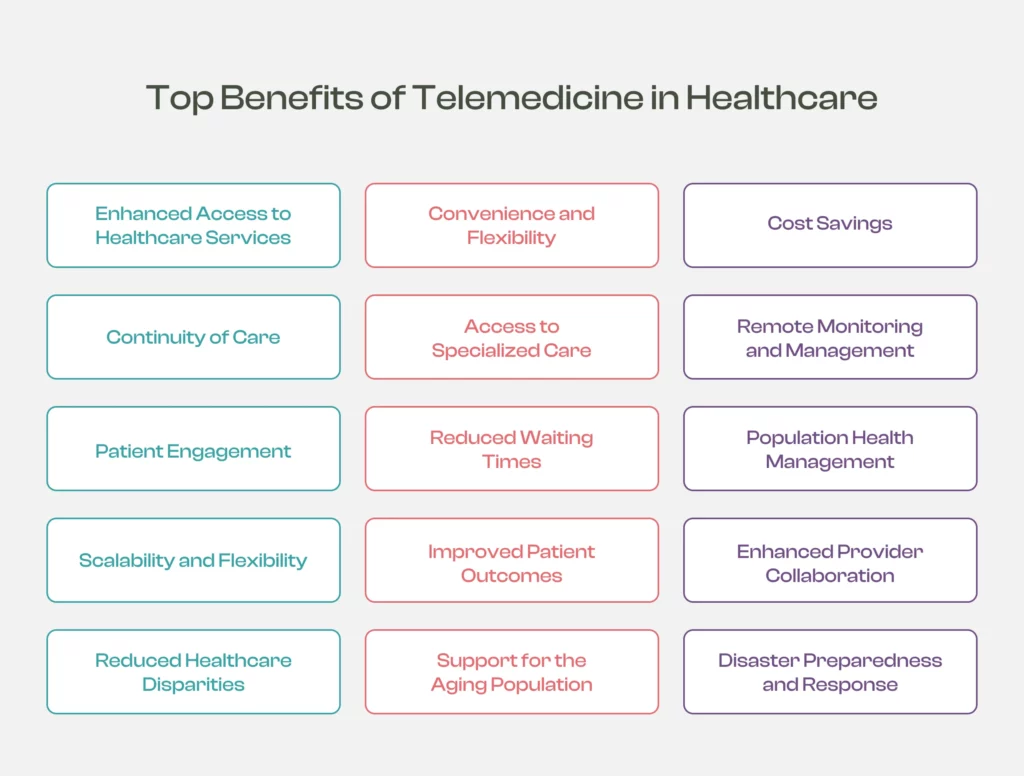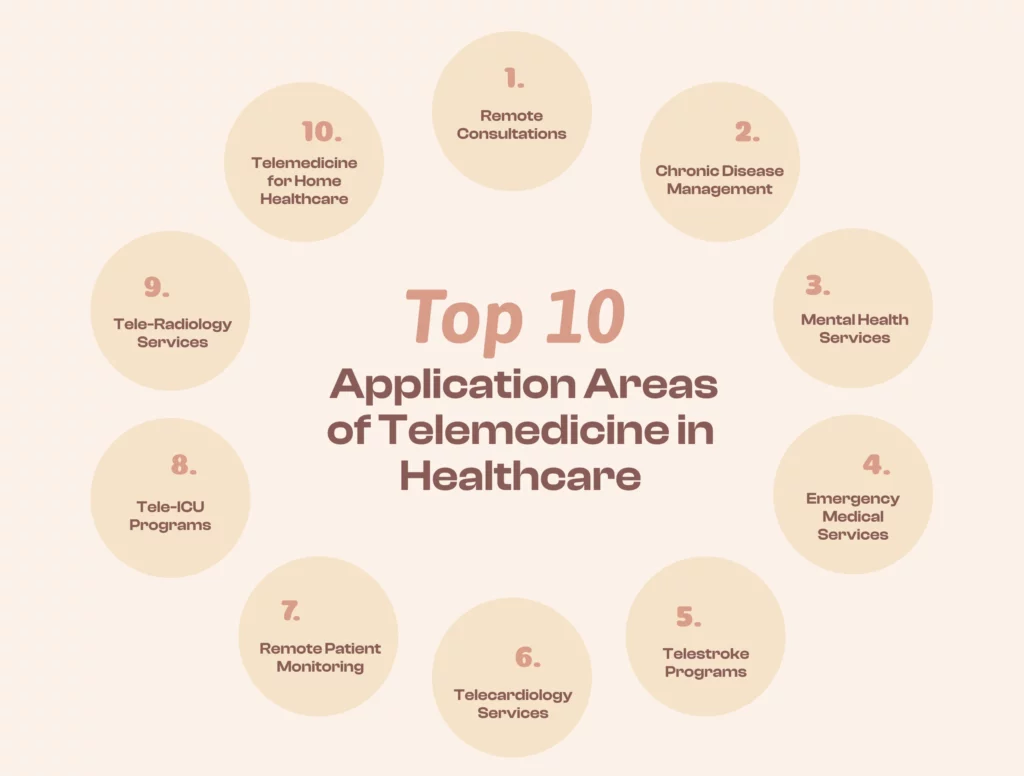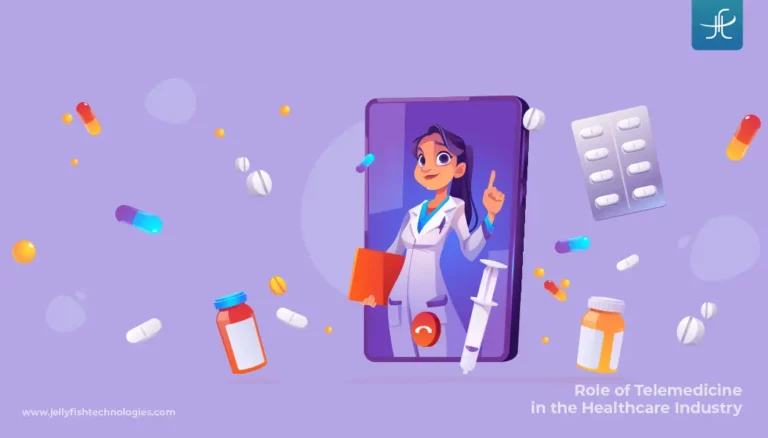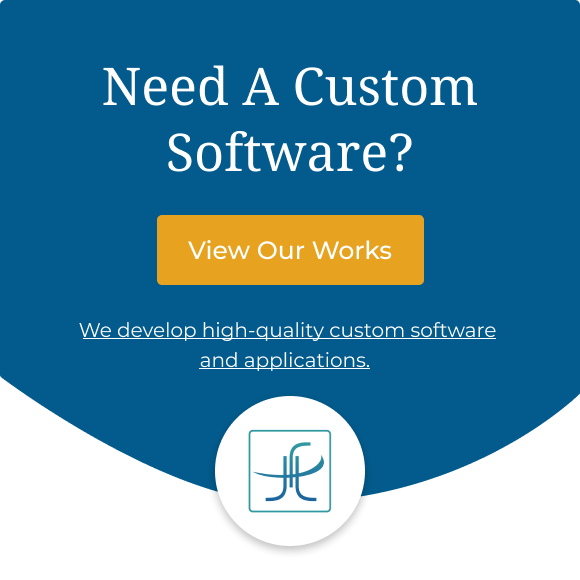In recent years, telemedicine has emerged as a transformative force in healthcare delivery, revolutionizing the way patients access medical services and interact with healthcare providers.
According to Mordor Intelligence, the telemedicine market size is estimated at USD 172.44 billion in 2024 and is expected to reach USD 330.26 billion by 2029, growing at a CAGR of 13.88% during the forecast period (2024-2029).
As technology continues to advance, the scope and capabilities of telemedicine in the health system have expanded, offering unprecedented convenience, accessibility, and efficiency in healthcare delivery.
Let us now delve into the intricacies of telemedicine and its profound impact on modern healthcare delivery.
What is Telemedicine in Healthcare?
Telemedicine refers to the remote diagnosis and treatment of patients using telecommunications technology. Through secure video conferencing, mobile apps, and other digital platforms, patients can consult with healthcare professionals from the comfort of their homes, eliminating the need for in-person visits to medical facilities.
Key Components of Telemedicine
Virtual Consultations
Telemedicine enables patients to schedule virtual appointments with healthcare providers for routine check-ups, follow-up visits, or non-emergency medical issues. These consultations allow for real-time communication and interaction between patients and providers, fostering personalized care and patient engagement.
Remote Monitoring
With the integration of wearable devices and remote monitoring technologies, telemedicine enables healthcare providers to remotely track and monitor patients’ vital signs, symptoms, and health metrics. This real-time data allows for proactive intervention and timely adjustments to treatment plans, leading to better health outcomes and reduced hospitalizations.
Electronic Prescriptions
Telemedicine platforms facilitate the electronic prescribing of medications, streamlining the prescription renewal process and improving medication adherence. Patients can receive prescriptions directly through secure digital channels, enhancing convenience and accessibility while minimizing delays in treatment.
Let’s now delve into the different benefits that telemedicine provides to the healthcare system.
Top 15 Benefits of Telemedicine in Healthcare
Telemedicine offers a plethora of benefits that significantly contribute to enhancing healthcare delivery and patient outcomes within the healthcare system.
Let’s explore some of the key advantages in greater detail.

Enhanced Access to Healthcare Services
Telemedicine transcends geographical barriers, ensuring equitable access to healthcare for individuals in remote or underserved areas. This accessibility facilitates timely interventions, promotes preventive care, and addresses healthcare disparities.
Convenience and Flexibility
Telemedicine in healthcare offers unparalleled convenience by enabling patients to schedule virtual appointments at their convenience. This flexibility eliminates the need for extensive travel and reduces wait times, enhancing patient satisfaction and adherence to treatment plans.
Cost Savings
Telemedicine generates significant cost savings for patients and healthcare organizations alike. By minimizing travel expenses and reducing the burden of in-person visits, telemedicine lowers overall healthcare costs and improves affordability for patients, especially those with chronic conditions requiring frequent monitoring.
Continuity of Care
Through seamless communication among healthcare providers, telemedicine in the health system ensures continuity of care for patients across different specialties and settings. This comprehensive approach to care reduces the risk of medical errors, improves treatment adherence, and enhances patient outcomes.
Access to Specialized Care
Telemedicine expands access to specialized medical expertise, allowing patients to receive timely consultations and treatment recommendations from specialists regardless of their location. This access to specialized care improves diagnostic accuracy, facilitates personalized treatment plans, and enhances overall patient satisfaction.
Remote Monitoring and Management
Telemedicine enables remote monitoring of patient’s health conditions, empowering healthcare providers to track vital signs, medication adherence, and disease progression in real time. This proactive approach to healthcare management facilitates early intervention, prevents complications, and promotes self-management skills among patients.
Legacy App Modernization and Custom Web App Development for a Leading Proptech Company
Patient Engagement
Telemedicine in healthcare promotes active patient engagement by fostering collaborative decision-making and communication between patients and healthcare providers. Patients feel more empowered to participate in their care, ask questions, and adhere to treatment recommendations, leading to improved health outcomes and patient satisfaction.
Reduced Waiting Times
By reducing wait times for appointments and consultations, telemedicine ensures timely access to healthcare services, particularly for patients with urgent medical needs. This reduction in waiting times improves patient satisfaction, enhances provider efficiency, and optimizes resource utilization within healthcare organizations.
Population Health Management
Telemedicine facilitates population health management by enabling proactive outreach to underserved communities, monitoring health trends, and implementing targeted interventions to address prevalent health issues. This population-based approach to healthcare promotes disease prevention, reduces healthcare disparities, and improves overall community well-being.
Scalability and Flexibility
Telemedicine offers scalability and flexibility for healthcare organizations to adapt to evolving patient needs and delivery models. By leveraging telemedicine services, organizations can expand their services, reach new patient populations, and innovate in healthcare delivery, ensuring optimal resource allocation and responsiveness to changing healthcare trends.
Improved Patient Outcomes
Telemedicine contributes to improved patient outcomes by facilitating proactive interventions, personalized treatment plans, and continuous monitoring of health metrics. By empowering patients to engage in their care and access timely medical advice, telemedicine helps prevent disease progression, reduce hospital readmissions, and optimize treatment outcomes.
Enhanced Provider Collaboration
Telemedicine fosters collaboration among healthcare providers by enabling seamless communication and information sharing. Through virtual consultations and electronic health records (EHR) systems, providers can collaborate on patient care, share expertise, and coordinate treatment plans more effectively, leading to better care coordination and improved patient outcomes.
Reduced Healthcare Disparities
Telemedicine helps bridge healthcare disparities by increasing access to medical services for underserved populations, including rural communities, low-income individuals, and minorities. By offering virtual consultations and remote monitoring options, telemedicine ensures that all patients have access to high-quality healthcare services, regardless of their socioeconomic status or geographic location.
Support for the Aging Population
Telemedicine in healthcare provides vital support for the aging population by enabling older adults to access healthcare services from the comfort of their homes. Through virtual consultations, remote monitoring devices, and telehealth applications, seniors can receive medical care, manage chronic conditions, and maintain independence while minimizing the need for frequent travel to healthcare facilities.
Disaster Preparedness and Response
Telemedicine in the health system plays a crucial role in disaster preparedness and response by ensuring continuity of care during emergencies, natural disasters, and public health crises. By offering remote consultations and telemedicine platforms, healthcare providers can deliver essential medical services, triage patients, and coordinate emergency responses more effectively, thereby saving lives and minimizing disruptions to healthcare delivery.
Significant Application Areas of Telemedicine in Healthcare
Telemedicine, with its diverse applications, plays a pivotal role in transforming healthcare delivery across various domains. Let’s explore the top significant application areas where telemedicine is making a profound impact.

Remote Consultations
Telemedicine facilitates remote consultations between patients and healthcare providers, enabling individuals to seek medical advice without physical visits to healthcare facilities.
Through secure video conferencing and telecommunication technologies, patients can discuss their symptoms, receive diagnoses, and obtain treatment recommendations from qualified healthcare professionals, enhancing accessibility and convenience.
Chronic Disease Management
Telemedicine services offer valuable support in managing chronic diseases, such as diabetes, hypertension, and cardiovascular conditions.
Patients can utilize telemonitoring devices to track their vital signs, medication adherence, and disease progression from the comfort of their homes. Whereas, healthcare providers can remotely monitor patients’ health metrics, identify trends, and intervene promptly to prevent complications, improving patient outcomes and quality of life.
Mental Health Services
Telemedicine plays a critical role in delivering mental health services, particularly in addressing barriers to accessing care, such as stigma and geographical constraints.
Through virtual counseling sessions and telepsychiatry programs, individuals can receive timely mental health support, counseling, and therapy from licensed professionals, promoting early intervention, reducing treatment delays, and enhancing mental well-being.
Emergency Medical Services
In emergencies, telemedicine enables timely access to medical expertise and support, even in remote or underserved areas.
Emergency medical personnel can use telemedicine platforms to consult with specialists, share vital patient information, and receive real-time guidance on diagnosis and treatment protocols, improving the quality of emergency care and patient outcomes.
Telestroke Programs
Telemedicine has revolutionized stroke care through telestroke programs, which allow neurologists to remotely assess and diagnose stroke patients in emergency departments.
By leveraging telecommunication technologies and advanced imaging systems, neurologists can conduct virtual evaluations, interpret brain scans, and recommend appropriate treatments such as thrombolytic therapy, leading to faster interventions and better outcomes for stroke patients.
Telecardiology Services
Telemedicine plays a crucial role in delivering cardiology services to remote or underserved populations, enabling timely diagnosis and management of cardiovascular conditions.
Through remote monitoring devices and teleconsultations, cardiologists can assess patients’ cardiac health, review diagnostic tests, and provide personalized treatment plans, reducing the burden on healthcare facilities and improving patient access to cardiac care.
Remote Patient Monitoring
Telemedicine facilitates remote patient monitoring, allowing healthcare providers to track patients’ health metrics and vital signs outside traditional clinical settings.
By utilizing wearable devices, sensors, and mobile health applications, healthcare teams can monitor patients with chronic conditions, detect early warning signs, and intervene proactively to prevent exacerbations or hospitalizations, promoting personalized, proactive care delivery.
Tele-ICU Programs
Telemedicine enhances critical care delivery through tele-ICU programs, which enable intensivists to remotely monitor and manage patients in intensive care units (ICUs).
Using telecommunication technologies and advanced monitoring systems, intensivists can remotely assess patients’ conditions, review real-time data, and collaborate with onsite healthcare teams to optimize care delivery, reduce complications, and improve patient outcomes in ICU settings.
Tele-Radiology Services
Telemedicine facilitates the efficient interpretation and distribution of medical imaging studies through teleradiology services.
Radiologists can remotely review and interpret imaging studies such as X-rays, MRIs, and CT scans, providing timely diagnostic insights to referring physicians and healthcare facilities. This enables faster diagnosis, treatment planning, and coordination of care, particularly in rural or remote areas with limited access to onsite radiologists.
Telemedicine for Home Healthcare
Telemedicine empowers patients to receive comprehensive healthcare services in the comfort of their homes, promoting aging in place and improving access to care for homebound individuals.
Home healthcare providers can use telemedicine platforms to conduct virtual visits, administer medications, and monitor patients’ health status remotely, enabling continuity of care and promoting independence among patients with chronic illnesses or disabilities.
Future Trends and Innovations in Telemedicine for Healthcare:
As we look to the future, several trends and innovations are poised to shape the landscape of telemedicine in healthcare. Let’s go through them one by one.
Artificial Intelligence (AI) and Machine Learning
AI and machine learning services are revolutionizing telemedicine by enabling advanced data analytics, predictive modeling, and personalized healthcare insights.
Furthermore, AI-powered algorithms can analyze vast amounts of patient data to identify patterns, predict disease progression, and recommend personalized treatment plans, enhancing diagnostic accuracy and treatment outcomes.
Remote Patient Monitoring Devices
The proliferation of wearable devices and IoT (Internet of Things) technology is transforming remote patient monitoring in telemedicine. These devices can continuously monitor patients’ vital signs, activity levels, and medication adherence, transmitting real-time data to healthcare providers for remote monitoring and timely intervention.
Additionally, this trend enables proactive, personalized care delivery and empowers patients to take control of their health.
Virtual Reality (VR) and Augmented Reality (AR)
VR and AR technologies are expanding the scope of telemedicine by creating immersive, interactive experiences for patients and healthcare providers.
These technologies enable virtual medical simulations, immersive training programs, and remote surgical assistance, enhancing medical education, surgical outcomes, and patient engagement in telemedicine settings.
Telemedicine Platforms and Mobile Apps
The development of user-friendly telemedicine platforms and mobile apps is democratizing access to healthcare services and facilitating seamless communication between patients and providers. These platforms offer secure video conferencing, appointment scheduling, electronic health records (EHR) integration, and prescription management features, streamlining the telemedicine experience for both patients and healthcare professionals.

For those eager to discover the intricacies of developing a healthcare mobile app, delve into this insightful guide: How to Build a Healthcare Mobile App: Steps, Types, and Features.
Tele-ICU and Tele-Surgery
The expansion of tele-ICU and telesurgery programs is revolutionizing critical care and surgical interventions through remote monitoring and surgical assistance.
Tele-ICU enables intensivists to monitor and manage patients in ICU settings remotely. At the same time, tele-surgery facilitates remote surgical consultations, training, and assistance, enabling access to specialized surgical expertise in remote or underserved areas.
Telepsychiatry and Mental Health Services
Telepsychiatry is gaining momentum as a cost-effective and accessible way to deliver mental health services to patients in need.
Telepsychiatry broadens access to mental healthcare by offering virtual counseling sessions, remote psychiatric assessments, and online therapy programs. This approach not only reduces the stigma surrounding mental health but also enhances patient engagement within telemedicine platforms.
Tele-Dermatology and Remote Diagnostics
Tele-dermatology and remote diagnostic services leverage telemedicine technology to enable remote skin consultations, dermatological assessments, and diagnostic imaging interpretation. These services facilitate timely diagnosis and treatment of skin conditions, expedite referrals to specialists, and enhance access to dermatological care in telemedicine environments.
Blockchain Technology
Blockchain technology holds promise for enhancing security, interoperability, and transparency in telemedicine transactions and health data management.
By leveraging blockchain-based solutions, telemedicine platforms can ensure secure storage and sharing of sensitive patient information, facilitate seamless data exchange between stakeholders, and enable immutable audit trails for healthcare transactions, enhancing trust and data integrity in telemedicine ecosystems.
If you are interested in learning about the benefits and use cases of blockchain in healthcare, you may find this article helpful: Blockchain in Healthcare: Benefits and Use Cases.
CTA
Unlock the full potential of telemedicine with Jellyfish Technologies’ cutting-edge healthcare software solutions.
Whether you’re looking to streamline remote consultations, enhance chronic disease management, or revolutionize mental health services, our team of experts is here to help.
GET IN TOUCH
Transform Your Healthcare System with Jellyfish Technologies’ Telemedicine Solutions
Transforming the healthcare industry requires the expertise of a leading healthcare software development company like Jellyfish Technologies. As pioneers in healthcare software development, we specialize in creating cutting-edge solutions tailored to the unique needs of the healthcare sector.
Our team of experienced healthcare software developers is dedicated to delivering high-quality software solutions that empower healthcare organizations to streamline their operations, improve patient care, and achieve better outcomes. Whether you’re a hospital, clinic, or healthcare provider, our healthcare software development services are designed to meet your specific needs and challenges.
So, get in touch with us today!


